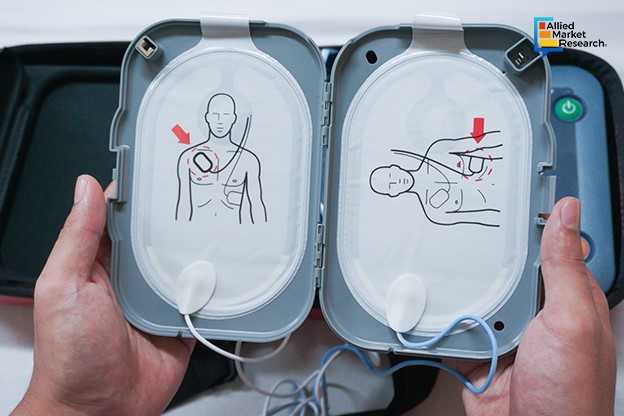How Are Modern External Defibrillators Revolutionizing Cardiac Care?

25 Feb
2025
Highlights:
- An introduction to external defibrillators
- Latest technological advancements in this sector
- Profitable alliances made by industry leaders in the domain
External defibrillators are key devices that are designed to treat life-threatening cardiac arrhythmias, specifically ventricular fibrillation and pulseless ventricular tachycardia. They have emerged as a significant innovation in defibrillator technology, enabling rapid response to cardiac arrest situations, which is essential for improving survival rates. These devices deliver an electrical shock to the heart to restore its normal rhythm. These advanced systems include accessories, such as batteries and pad electronics. These elements are necessary for the defibrillators to detect and interpret a person’s rhythm and deliver an electrical shock when needed.
Automated external defibrillators (AEDs) are mainly of two types, one for public access and the other one for professional use. Publicly accessed AEDs are usually found in airports, community centers, schools, government buildings, hospitals, and other public locations. They are designed to be used by common people who have received minimal training. On the other hand, professional AEDs are mostly used by first responders, such as emergency medical technicians (EMTs) and paramedics, who receive additional AED training.
Moreover, these devices are available in two formats, including semi-automated defibrillators and fully automated defibrillators. Semi-AEDs first analyze the heart rhythm of users. If any abnormality occurs, these devices prompt the user to press a button and deliver a defibrillation shock. However, fully automated defibrillators monitor the heart's rhythm and deliver a shock automatically if needed.
Advances in external defibrillators transforming cardiac arrest treatment
In the past few years, the external defibrillators industry has witnessed prominent growth due to continuous technological advancements in designing these cutting-edge devices. Moreover, the rise of modern technologies, such as AI, has enhanced the rhythm direction of AEDs. AI algorithms improve the accuracy of rhythm analysis, enabling defibrillators to distinguish between various arrhythmias more effectively than traditional methods. This leads to better decision-making regarding shock delivery. In addition, AI forecasts potential cardiac events, allowing for preventive measures rather than solely reactive responses.
On the other hand, the integration of IoT allows AEDs to transmit real-time data to healthcare providers, enhancing monitoring and response capabilities. This connectivity facilitates automatic software updates, ensuring devices remain compliant with the latest medical guidelines.
Moreover, dual sequential external defibrillation (DSED) has emerged as a new technique that employs defibrillators to deliver rapid sequential shocks. This method has potentially improved patient outcomes with specific heart conditions such as refractory ventricular fibrillation (VF). In this process, electrode pads are placed in anterolateral and anteroposterior positions to deliver electrical current from two different vectors. DSED is considered when VF persists after three standard defibrillation attempts and pharmacological interventions have failed.
Simultaneously, the advent of wearable AEDs has created wider opportunities for the sector. These modern devices monitor the heart’s rhythms continuously and deliver shocks automatically if life-threatening arrhythmias are detected. This proactive approach significantly enhances survival rates among patients worldwide. Moreover, increasing investments in R&D activities are expected to develop futuristic AEDs with enhanced capabilities, such as providing cardiopulmonary resuscitation (CPR) performance. This is anticipated to guide rescuers on compression depth and rate, thereby saving the lives of many critical cardiac patients in the future.
Philips partners with Bridgefield Capital to expand emergency care solutions
In January 2025, Royal Philips, a leading provider of healthcare technology solutions signed a brand license agreement with Bridgefield Capital, a leading US-based investment firm to sell its emergency care business. Through this partnership, Bridgefield Capital is able to use the Philips brand for manufacturing, sales, and marketing of emergency care products globally for a period of up to 15 years. The emergency care business offers a wide range of products that play an important role in acute care management, both inside and outside hospital. These diverse sets of products include cardiac resuscitation, such as automated external defibrillators, and emergency care devices for professional and consumer applications.
Endnote
Automated external defibrillators are promising tools in emergency medical care, significantly improving outcomes for patients experiencing cardiac arrest. Their user-friendly design, combined with ongoing technological advancements and public access initiatives, makes AEDs as essential components in efforts to save lives during critical health emergencies.
To gain deeper insights into the upcoming innovations in external defibrillators, feel free to reach out to our industry analysts !

Koyel Ghosh
Author’s Bio- Koyel Ghosh is a blogger with a strong passion and enjoys writing in miscellaneous domains, as she believes it lets her explore a wide variety of niches. She has an innate interest in creativity and enjoys experimenting with different writing styles. A writer who never stops imagining, she has been serving the corporate industry for the last five years.
How Have AI and Automation Expanded the Scope of the Laboratory Equipment and Disposables Industry?
Avenue: Entire Library membership of Allied Market Research Reports at your disposal
- Avenue is an innovative subscription-based online report database.
- Avail an online access to the entire library of syndicated reports on more than 2,000 niche industries and company profiles on more than 12,000 firms across 11 domains.
- A cost-effective model tailored for entrepreneurs, investors, and students & researchers at universities.
- Request customizations, suggest new reports, and avail analyst support as per your requirements.
- Get an access to the library of reports at any time from any device and anywhere.
Related Post
-
How are Submarine Cables Transforming Global Connectivity with Enhanced User Experience?
-
Endoscopy Procedures: Transformations in Techniques and Applications
-
AI-Powered Video Analytics: How the Product Actually Works for enterprises
-
Painting Robots: Transforming Precision Coating and Creative Applications
-
Innovations in Pharmacovigilance Systems Advancing Patient Safety
-
Understanding Edge Security: Keeping Data Safe Near the Source
-
Exploring the Use and Advancements of 3D Laser Scanners in Professional Applications
-
Reinforcing Industrial Controls with Smarter Tools and Training








